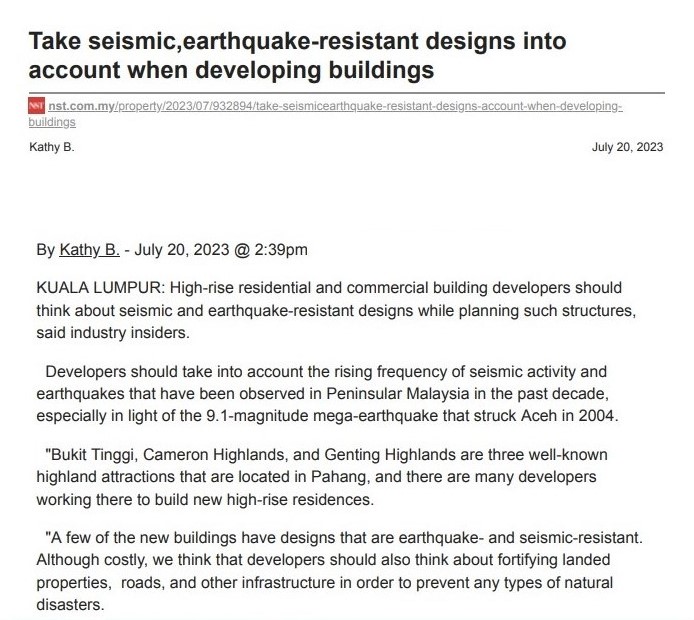NST Online – Take Seismic and Earthquake-Resistant Designs into Account When Developing Building Structures

KUALA LUMPUR: High-rise residential and commercial building developers should think about seismic and earthquake-resistant designs while planning such structures, said industry insiders.
Developers should take into account the rising frequency of seismic activity and earthquakes that have been observed in Peninsular Malaysia in the past decade, especially in light of the 9.1-magnitude mega-earthquake that struck Aceh in 2004.
"Bukit Tinggi, Cameron Highlands, and Genting Highlands are three well-known highland attractions that are located in Pahang, and there are many developers working there to build new high-rise residences.
"A few of the new buildings have designs that are earthquake- and seismic-resistant. Although costly, we think that developers should also think about fortifying landed properties, roads, and other infrastructure in order to prevent any types of natural disasters.
"However, all these come at a cost, and if the buyer is willing to pay more to protect against potential earthquakes, then the developer will be motivated to build," the insider said.
The need for strong foundations for beams, more flexible couplings between columns and beams, and the need for beams to be able to absorb stresses imposed by earthquake shocks horizontally are some of the considerations that must be made into building design standards, he told NST Property.
According to him, the "resonance effect" during an earthquake will depend on the height and natural frequency of the building.
Earthquakes and the catastrophic repercussions they might have had were thrust into the spotlight with the earthquake shocks that were felt in Malaysia in February of last year.
Perak, Selangor, Melaka, and Johor are the four states in Malaysia that experienced earthquake vibrations. These shocks were caused by an earthquake with a magnitude of 6.2 that struck 76 kilometres north of Paya Kumbah, Indonesia.
In the 24 hours that followed this catastrophe, numerous other earthquakes were registered across the globe. In actuality, a staggering 230 earthquakes with a magnitude greater than 3.0 were noted.
The closest big earthquake was a 5.1-magnitude one that struck Mindanao in the Philippines on February 26, 2022, according to Malaysia's Meteorological Department.
This is not the first time Malaysia has felt vibrations from an earthquake. A 7.4- magnitude earthquake that struck Aceh, Indonesia, on November 2, 2002, caused significant tremors in a number of major cities, including Penang, Port Klang, Selangor, and Old Klang Road, which have large populations of high-rise residential structures and commercial, and industrial properties.
A paper titled "Intraplate earthquake occurrence and distribution in Peninsular Malaysia over the past 100 years" that was published more than a year ago claimed that Peninsular Malaysia had experienced 59 earthquakes with magnitudes ranging from 2.4 to 4.6 between the years 1922 and 2020 (a period of 98 years).
Three earthquakes rattled the populous Bukit Tinggi neighbourhood in Pahang on November 30, 2007. Following that, 13 more earthquakes with magnitudes ranging from 2.5 to 3.0 were noted in the two months that followed.
According to Prof. Dr. Azlan Adnan, head of the Engineering Seismology and Earthquake Engineering Research Department at Universiti Teknologi Malaysia (UTM), the majority of the new government buildings constructed after 2017 are prepared to withstand earthquakes.
Last year, Azlan told Bernama that older structures constructed before 2017 may face the danger of incurring significant seismic damage.
He cited the 2015 six-magnitude earthquake in Ranau, Sabah, which left most of the buildings severely cracked and some rendered unusable due to improper building design and broken beams.
Tropicana uses earthquake-resistant designs for its project in Genting Highlands
The high-rise constructions by Tropicana Corporation Bhd in Genting Highlands, Pahang, have seismic- and earthquake-resistant architecture.
According to Ixora Ang, the company's executive director for marketing, sales, and business development, the most recent launch, TwinPines Serviced Suites located within Tropicana Grandhill, includes international Eurocode criteria for stability and earthquake resistance in addition to QLASSIC quality standards.
"The development as a whole has been designed for optimal safety, starting with a solid construction base and meticulous earthwork planning. TwinPines Serviced Suites showcases this approach with full compliance to Eurocode guidelines for earthquake resistance," she said.
In a recent statement, she said Tropicana is committed to building townships that are gateways to safe and thriving neighbourhoods.



